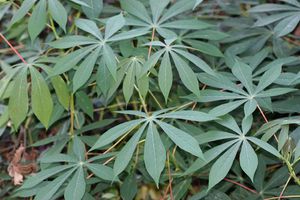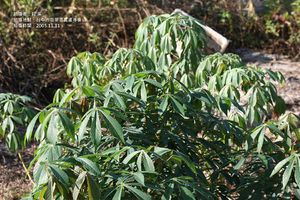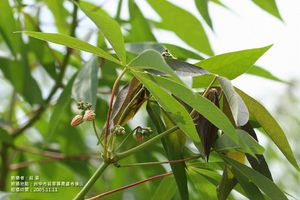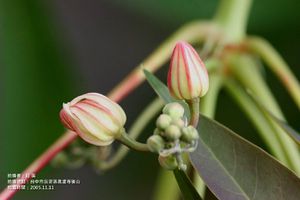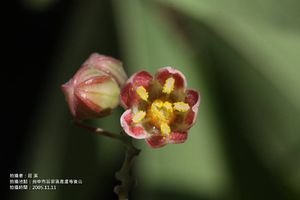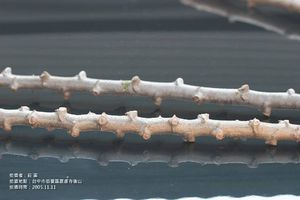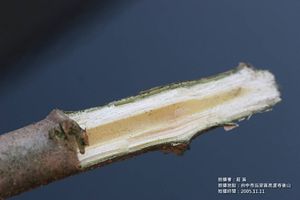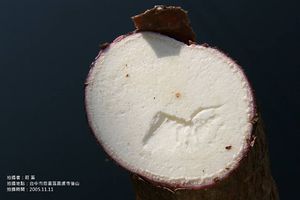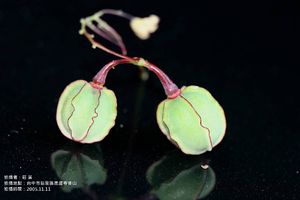樹薯
出自台灣有毒中草藥毒性資料庫
(→毒性研究) |
(→毒性分級) |
||
| (3個中途的修訂版本沒有顯示) | |||
| 第17行: | 第17行: | ||
{| border="2" style="border-collapse;" | {| border="2" style="border-collapse;" | ||
|| | || | ||
| - | [[檔案:|300px]] | + | [[檔案:樹薯03.JPG|300px]] |
| - | + | ||
| + | 樹薯葉 | ||
|| | || | ||
| - | [[檔案:|300px]] | + | [[檔案:樹薯07.JPG|300px]] |
| - | + | ||
| + | 樹薯 | ||
|| | || | ||
| - | [[檔案:|300px]] | + | [[檔案:樹薯-花序.jpg|300px]] |
| - | + | ||
| + | 樹薯花序 | ||
|| | || | ||
|- | |- | ||
|| | || | ||
| - | [[檔案: | + | [[檔案:樹薯-花04.jpg|300px|]] |
| + | 樹薯花1 | ||
| + | || | ||
| + | [[檔案:樹薯-花05.jpg|300px]] | ||
| + | 樹薯花2 | ||
|| | || | ||
| - | [[檔案:|300px]] | + | [[檔案:樹薯-莖.jpg|300px]] |
| + | 樹薯莖 | ||
| + | |- | ||
| + | || | ||
| + | [[檔案:樹薯-莖心1.jpg|300px]] | ||
| + | 樹薯莖心 | ||
|| | || | ||
| - | [[檔案: | + | [[檔案:樹薯-塊根.jpg|300px]] |
| + | 樹薯塊根 | ||
| + | || | ||
| + | [[檔案:樹薯-實1.jpg|300px]] | ||
| + | 樹薯果實 | ||
|} | |} | ||
</font> | </font> | ||
| - | |||
== '''樹薯簡介''' == | == '''樹薯簡介''' == | ||
| 第140行: | 第152行: | ||
=='''毒性分級'''== | =='''毒性分級'''== | ||
| - | <font size=4>[http://tcm-toxic.kmu.edu.tw/index.php/%E6%AF%92%E6%80%A7%E5%88%86%E9%A1%9E 級數 | + | <font size=4>[http://tcm-toxic.kmu.edu.tw/index.php/%E6%AF%92%E6%80%A7%E5%88%86%E9%A1%9E 級數]</font> |
| - | + | ||
== '''參考文獻''' == | == '''參考文獻''' == | ||
<font size=4> | <font size=4> | ||
| - | 1. | + | 1. Nzwalo H, Cliff J. [http://www.ncbi.nlm.nih.gov/pmc/articles/PMC3125150/ Konzo: from poverty, cassava, and cyanogen intake to toxico-nutritional neurological disease.] ''PLoS Neglencted Tropical Diseases'' 2011; 5: e1051. |
| - | 2. | + | 2. Padmaja G. [http://www.ncbi.nlm.nih.gov/pubmed/7576161 Cyanide detoxification in cassava for food and feed uses.] ''Critical Reviews in Food Science and Nutrition'' 1995; 35: 299-339. |
| - | 3. | + | 3. Li SS, Hu LF, Zhao YX, Zuo WJ, Zeng YB, Li XN, Mei WL, Dai HF. A new diterpene from the stems of Manihot esculenta. J Asian Nat Prod Res 2011; 13: 961-964. |
| - | 4. | + | 4. Yi B, Hu L, Mei W, Zhou K, Wang H, Luo Y, Wei X, Dai H. Antioxidant phenolic compounds of cassava (Manihot esculenta) from Hainan. Molecules 2011; 16: 10157-10167. |
| - | 5. | + | 5. Cereda MP, Mattos MCY. Linamarin: the Toxic Compound of Cassava. Journal of Venomous Animals and Toxins 1996; 2: 06-12. |
| - | 6. | + | 6. Prawat H, Mahidol C, Ruchirawat S, Prawat U, Tuntiwachwut-tikul P, Tooptakong U, Taylor WC, Pakawatchai C, Skeleton BW, White AH. Cyanogenic and non-cyanogenic glycosides from Manihot esculenta. Phytochemistry 1995; 40: 1167-1173. |
| - | 7. | + | 7. Tsumbu CN, Deby-Dupont G, Tits M, Angenot L, Franck T, Serteyn D, Mouithys-Mickalad A. Antioxidant and antiradical activities of Manihot esculenta Crantz (Euphorbiaceae) leaves and other selected tropical green vegetables investigated on lipoperoxidation and phorbol-12-myristate-13-acetate (PMA) activated monocytes. Nutrients 2011; 3: 818-838. |
| - | 8. | + | 8. Adeyemi OO, Yemitan OK, Afolabi L. Inhibition of chemically induced inflammation and pain by orally and topically administered leaf extract of Manihot esculenta Crantz in rodents. Journal of Ethnopharmacology 2008; 119: 6-11. |
| - | 9. | + | 9. Loh SP, Hadira O. In vitro inhibitory potential of selected Malaysian plants against key enzymes involved in hyperglycemia and hypertension. Malays J Nutr 2011; 17: 77-86. |
| - | 10. | + | 10. Boby RG, Indira M. Effect of co-administration of cassava (Manihot esculenta Crantz) rich diet and alcohol in rats. Indian J Physiol Pharmacol 2004; 48: 41-50. |
| - | 11. | + | 11. Teles FF. Chronic poisoning by hydrogen cyanide in cassava and its prevention in Africa and Latin America. Food Nutr Bull 2002; 23: 407-412. |
| - | 12. | + | 12. Santos KS, Galvao CE, Gadermaier G, Resende VMF, Martins CD, Misumi DS, Yang AC, Ferreira F, Palma MS, Kalil J, Castro FFM. Allergic reactions to manioc (Manihot esculenta Crantz): Identification of novel allergens with potential involvement in latex-fruit |
| + | syndrome. Journal of Allergy and Clinical Immunology 2011; 128: 1367-1369. | ||
| - | 13. | + | 13. Ibero M, Castillo MJ, Pineda F. Allergy to cassava: A new allergenic food with cross-reactivity to latex. Journal of Investigational Allergology and Clinical Immunology 2007; 17: 409-412. |
| + | |||
| + | 14. Gaspar A, Neto-Braga C, Pires G, Murta R, Morais-Almeida M, Rosado-Pinto J. Anaphylactic reaction to manioc: cross-reactivity to latex. Allergy 2003; 58: 683-684. | ||
| + | |||
| + | 15. Oke OL. The Role of Hydrocyanic Acid in Nutrition. World Review of Nutrition and Dietetics 1969; 11: 170-198. | ||
</font> | </font> | ||
| + | |||
{| | {| | ||
在2012年10月30日 (二) 13:39的最新修訂版本
| 中英文學名 | 科別 | 毒性 | 症狀 |
基本資料
|
科別 | 大戟科 Euphorbiaceae |
|
屬名 | 樹薯屬 Manihot |
|
中文學名 | 樹薯 |
|
拉丁學名 | Manihot esculenta Crantz |
|
英文名稱 | Cassava, Manioc, pucuk ubi |
|
中文俗名 | 木薯、臭薯、葛薯、樹番薯、番薯樹、紫香薯、薯樹、食用樹薯 |
植物圖片
|
樹薯葉 |
樹薯 |
樹薯花序 | |
|
樹薯花1 |
樹薯花2 |
樹薯莖 | |
|
樹薯莖心 |
樹薯塊根 |
樹薯果實 |
樹薯簡介
樹薯主要源自於中美洲及南美洲地區,成份當中含有大量的碳水化合物(carbohydrate),因此在熱帶地區的國家是日常生活主食之ㄧ,但樹薯含有大量的糖苷氰化物(cyanogenic glycosdies),其中以linamarin, lotaustralin這兩種為最主要的有毒物質。由於這個原因,樹薯在非洲地區造成一種神經共濟失調的癱瘓性疾病,稱作konzo[1]。樹薯在食用前,可經過日曬延長linamarase和糖苷的作用時間,而去除多數的氰化物;另外,樹薯根先經浸泡(soaking)再煮沸(boiling),移除氰化物的效果會比單獨使用浸泡或煮沸更好[2]。
外觀簡述
|
莖 | 高約 1~3 公尺,塊根圓柱狀,肉質、肥厚,故又稱木薯,莖有乳汁,木質、粗壯,上部分枝。木薯是著名澱粉作物,塊根。 |
|
葉 | 單葉互生,掌狀 3~7 深裂或全裂,各裂片呈倒披針形,全緣,葉柄長約 30~50 公分,基部膨大,中空,折斷有膠絲,葉脫落後在莖上留存葉痕。 |
|
花 | 花單性,圓錐花序,雌雄同株而異花,圓錐花序頂生或腋生;花萼大,鐘狀,5 裂,呈花瓣狀,黃白而帶紫色,花盤腺體 5 枚;無花瓣;雄花 10 枚,2 輪;雌花子房 3 室,花柱 3,下部合生。 |
|
果實 | 果實為蒴果,橢圓形或圓球形,徑約 1.5 公分,有 6 條狹波狀縱稜,熟時 3 裂;內有種子 3 粒,形如蓖麻子。 |
產地
原產於中美及南美洲,17世紀時傳到非洲及印度,主要種植在熱帶及亞熱帶地區。
使用情況
活性成份
|
莖[3, 4] |
|
|
葉[5, 6] |
|
|
根[5, 6] |
|
活性研究
- 1. 抗氧化[4, 7]
- 2. 抗發炎:將樹薯葉水萃取物以100-400 mg/kg經口給予大鼠,或製成1-4%的凡士林膏局部塗抹於患處。經口給予可顯著減緩carrageenan誘導產生的足底水腫以及甲苯(xylene)誘導產生的耳朵水腫。同時也發現可顯著減緩因醋酸(acetic acid)及乙醯膽鹼(acetylcholine)引起的疼痛扭曲[8]。
- 3. 降血糖:樹薯葉己烷及二氯甲烷萃取物抑制alpha-amylase的能力分別為59.22%及54.15%[9]。
- 4. 同時餵食實驗動物樹薯及乙醇,發現樹薯可降低酒精所引起的毒性作用,主要是降低肝臟及血清中的GOP, GPT, GGT, acid phosphatase, alkaline phosphatese[10]。
毒性研究
- 症狀
- 1. konzo(一種造成癱瘓的疾病,屬於神經共濟失調病症(ataxic neuropathy))[11]
- 2. 過敏反應(allergic reaction)[12-14]
- 有毒成分
- 1. linamarin [2-(β-D-glucopyranosyloxy)isobutyronitrile]
- 2. lotaustralin
- 3. hydrocyanic acid (一般根部含量為15~400 mg/kg, 多數為30-150 mg/kg)
- 4. 2-((6-O-(β-D-apiofuranosyl)-β-D-glucopyranosyl)oxy)-2-methylbutanenitrile
- 中毒劑量
- 1. 致死劑量1 mg/kg of live weight[15]
- 2. 小鼠,皮下注射,LD50:2.5±0.3 g/kg[8]
- 機轉
- 樹薯當中所含的氰苷類物質造成的中毒症狀,主要是經由氰苷類物質與血液中的二價鐵離子結合後形成氰化血紅蛋白(cyanohemoglobin)[5]。
- 毒性
毒性分級
參考文獻
1. Nzwalo H, Cliff J. Konzo: from poverty, cassava, and cyanogen intake to toxico-nutritional neurological disease. PLoS Neglencted Tropical Diseases 2011; 5: e1051.
2. Padmaja G. Cyanide detoxification in cassava for food and feed uses. Critical Reviews in Food Science and Nutrition 1995; 35: 299-339.
3. Li SS, Hu LF, Zhao YX, Zuo WJ, Zeng YB, Li XN, Mei WL, Dai HF. A new diterpene from the stems of Manihot esculenta. J Asian Nat Prod Res 2011; 13: 961-964.
4. Yi B, Hu L, Mei W, Zhou K, Wang H, Luo Y, Wei X, Dai H. Antioxidant phenolic compounds of cassava (Manihot esculenta) from Hainan. Molecules 2011; 16: 10157-10167.
5. Cereda MP, Mattos MCY. Linamarin: the Toxic Compound of Cassava. Journal of Venomous Animals and Toxins 1996; 2: 06-12.
6. Prawat H, Mahidol C, Ruchirawat S, Prawat U, Tuntiwachwut-tikul P, Tooptakong U, Taylor WC, Pakawatchai C, Skeleton BW, White AH. Cyanogenic and non-cyanogenic glycosides from Manihot esculenta. Phytochemistry 1995; 40: 1167-1173.
7. Tsumbu CN, Deby-Dupont G, Tits M, Angenot L, Franck T, Serteyn D, Mouithys-Mickalad A. Antioxidant and antiradical activities of Manihot esculenta Crantz (Euphorbiaceae) leaves and other selected tropical green vegetables investigated on lipoperoxidation and phorbol-12-myristate-13-acetate (PMA) activated monocytes. Nutrients 2011; 3: 818-838.
8. Adeyemi OO, Yemitan OK, Afolabi L. Inhibition of chemically induced inflammation and pain by orally and topically administered leaf extract of Manihot esculenta Crantz in rodents. Journal of Ethnopharmacology 2008; 119: 6-11.
9. Loh SP, Hadira O. In vitro inhibitory potential of selected Malaysian plants against key enzymes involved in hyperglycemia and hypertension. Malays J Nutr 2011; 17: 77-86.
10. Boby RG, Indira M. Effect of co-administration of cassava (Manihot esculenta Crantz) rich diet and alcohol in rats. Indian J Physiol Pharmacol 2004; 48: 41-50.
11. Teles FF. Chronic poisoning by hydrogen cyanide in cassava and its prevention in Africa and Latin America. Food Nutr Bull 2002; 23: 407-412.
12. Santos KS, Galvao CE, Gadermaier G, Resende VMF, Martins CD, Misumi DS, Yang AC, Ferreira F, Palma MS, Kalil J, Castro FFM. Allergic reactions to manioc (Manihot esculenta Crantz): Identification of novel allergens with potential involvement in latex-fruit syndrome. Journal of Allergy and Clinical Immunology 2011; 128: 1367-1369.
13. Ibero M, Castillo MJ, Pineda F. Allergy to cassava: A new allergenic food with cross-reactivity to latex. Journal of Investigational Allergology and Clinical Immunology 2007; 17: 409-412.
14. Gaspar A, Neto-Braga C, Pires G, Murta R, Morais-Almeida M, Rosado-Pinto J. Anaphylactic reaction to manioc: cross-reactivity to latex. Allergy 2003; 58: 683-684.
15. Oke OL. The Role of Hydrocyanic Acid in Nutrition. World Review of Nutrition and Dietetics 1969; 11: 170-198.
| 中英文學名 | 科別 | 毒性 | 症狀 |
